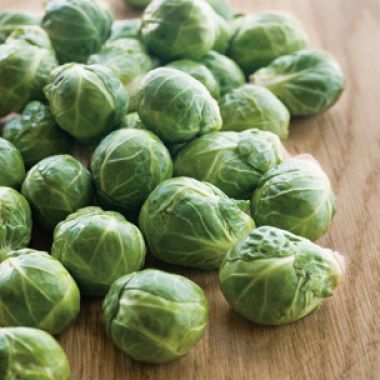
Members of the cabbage family, brussels sprouts grow on long, curving stalks as small, tightly closed heads that resemble tiny cabbages. The tops of the stalks have spreading leaves, making these impressive-looking plants when in the field. Brussels sprouts grow best in cool, coastal regions and are in season in the fall and winter. They may be boiled, braised or steamed, or parboiled and then sautéed.
Selecting
Buy fresh brussels sprouts that are heavy for their size and bright green, with leaves clinging tightly to the heads. Avoid any with yellowing leaves, which indicate aging. They may be pale green at the base. Check that the stem ends are freshly cut. Also avoid soft heads with loose leaves. Small heads, about 1 inch in diameter, are usually preferable to large ones, which can be almost twice that size. If the large heads are dark green and firm, however, they should taste good.
Fresh brussels sprouts are sold loose or packed in pint baskets or small tubs, although at some farmers markets you can buy them on the stalks. Brussels sprouts freeze well, so if fresh are not available, buy them frozen.
Storing
Store in plastic bags or the original packaging in the refrigerator for up to 4 days, but try to eat them as soon as possible after purchase. To freeze, rinse and dry the heads and blanch for 4 to 5 minutes, depending on their size. Then refresh in cold water, drain and freeze in sturdy freezer bags or rigid containers.
Preparing
Rinse and dry the heads. Trim any brown outside leaves and trim away the stem ends. Cut a shallow X into the stem end before cooking so that the heads will cook quickly and evenly. Larger heads can be halved or quartered before cooking.
If you encounter loose-leafed brussels sprouts, simply take apart the heads and separate and steam the individual leaves.
Adapted from Williams-Sonoma Kitchen Companion: The A to Z Guide to Everyday Cooking, Equipment and Ingredients (Time-Life Books, 2000)
Related Recipes:
- Brussels Sprouts with Toasted Hazelnuts →
- Roasted Brussels Sprouts with Bacon and Chestnuts →
- Pan-Roasted Winter Vegetables →
- Scallops with Brussels Sprouts & Bacon →
- Buttered Brussels Leaves →
- Brussels Sprouts with Radicchio & Pancetta →
- Brussels Sprouts and Potato Hash with Fried Eggs →
- Brussels Sprout and Arugula Salad with Walnuts →
- Brussels Sprout Leaves with Bacon →
- Sautéed Brussels Sprouts with Olive Oil and Lemon Peel →













